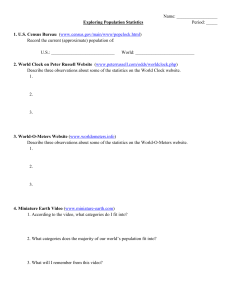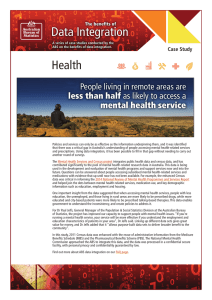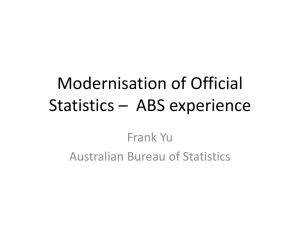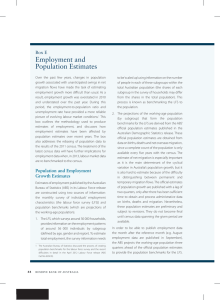Community Indicators Workshop Sept 06 SMT
advertisement
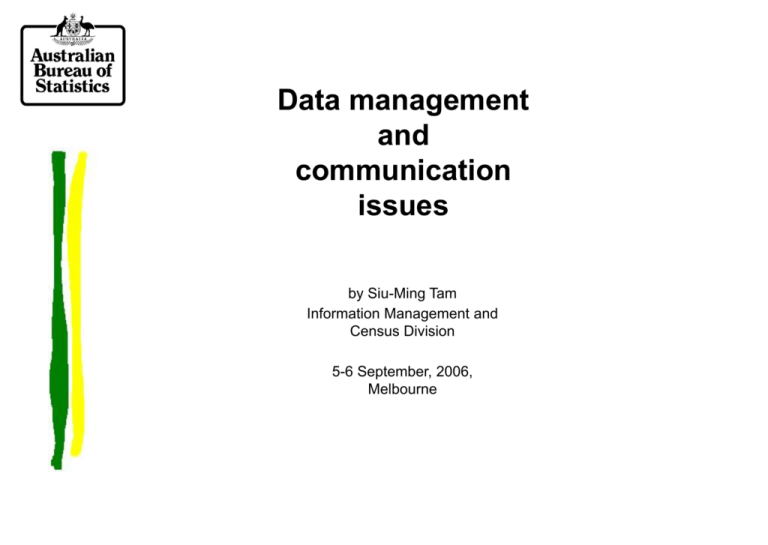
Data management and communication issues by Siu-Ming Tam Information Management and Census Division 5-6 September, 2006, Melbourne What am I going to cover? Data communication why, whats and hows upstream processes data dissemination and data management ABS strategies and actions to achieve data communication may/may not apply to the communication of indicators 2006 Census output plans - time permitting A statistical processing model Design Evaluate Communicate Disseminate Collect Process Manage A statistical processing model (cont'd) "Design" to address statistical needs and objectives what is a good indicator? Which indicator? what is a community? drill down/roll up capabilities? "Manage" to ensure consistency and coherence of meta data and statistical data policy/protocol for data access, change and archival particularly important for regular releases reputation management - one single version of "truth" efficiency - writing once/publishing many times Output warehouse model Dissemination vs Communication Output vs outcomes Key factors for communication Content itself Story telling Presentation of the materials Data Communication What? sharing of information between producers of statistics to users in a way that enables understanding 2-way communication Why? increase informed use of indicators understand information content, context, caveats and limitations to determine 'fitness for purpose' decreased likelihood of data misinterpretation/misuse How? - how does the mind comprehend information? How does the mind comprehend information? Cognitive psychology and cognitive processes: perception - attaching meaning to sensory information attention - focusing on sensory information learning - reinforcing or coding into long term memory presentational methods not a distraction for learning new information from statistics How to maximise comprehension? Presentational issues appropriate cognitive load appropriate organisation cues - "context shrinks" use alerting techniques - attention "economics" Content issues simple to complex presentation reduce propositional complexity write for the audience contextually link metadata and statistical data How to maximise comprehension? (cont'd) Tell interesting statistical stories Allow users to discover patterns in statistical data From theory to practice - ABS key strategies Presentational Use Gestalt Laws and alerting techniques Organise information in layers - tourists/harvestors/miners hence broadcasting Ensure density of information suits audience and purpose Content Link metadata and statistical data contextually Improve 'Writing for Web' - web surfers behaviours From theory to practice - ABS key strategies (cont'd) Data visualisation Develop interesting stories Help people detect patterns in the data Examples and prototypes Contextual linking of metadata from statistical data - a prototype www.abs.gov.au/about/ePublication Making statistical stories interesting - data visualisation Population pyramid Dashboard GapMinder MDG Issues What tools to use to tell interesting stories about indicators? How to manage the community indicators and metadata? What policy and standards need to be put in place? How to create the relevant culture for supporting data management? How to communicate metadata to assist interpretation of indicators? One warehouse, or eight warehouses? What role can NDN play in all these? 2006 Census outputs Paper products Statistician's report Social Atlases Static web based products Quick statistics Quick maps - Social Atlases on line Census tables Community profiles 2006 Census outputs (cont'd) Dynamic web based products Census on-line "slicing and dicing of data cubes" + mapping capabilities Table Builder generating census tables via 100% file with built in confidentiality protection Release schedule Progressively released from Jul/Aug 07 Pricing - all free except Table Builder Demonstration - time permitting







